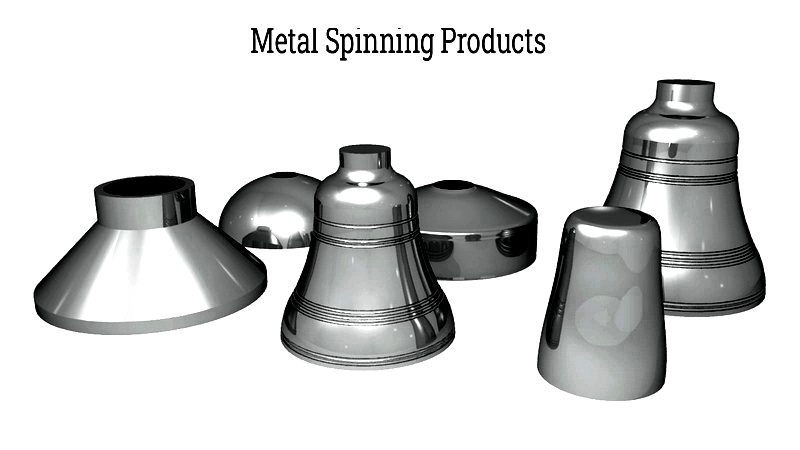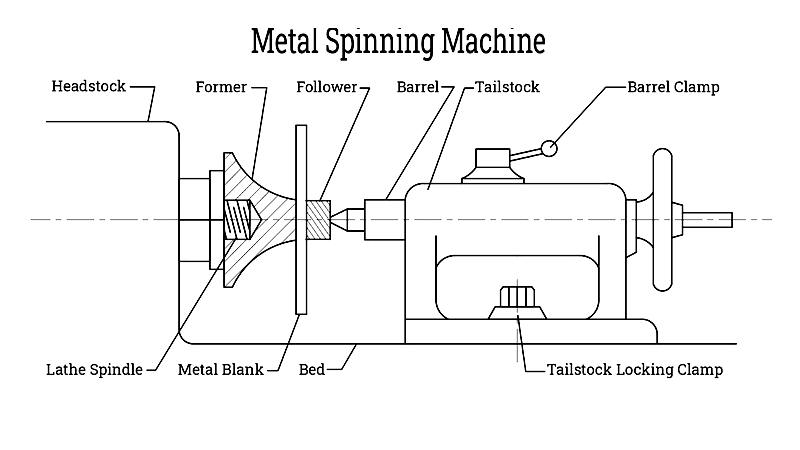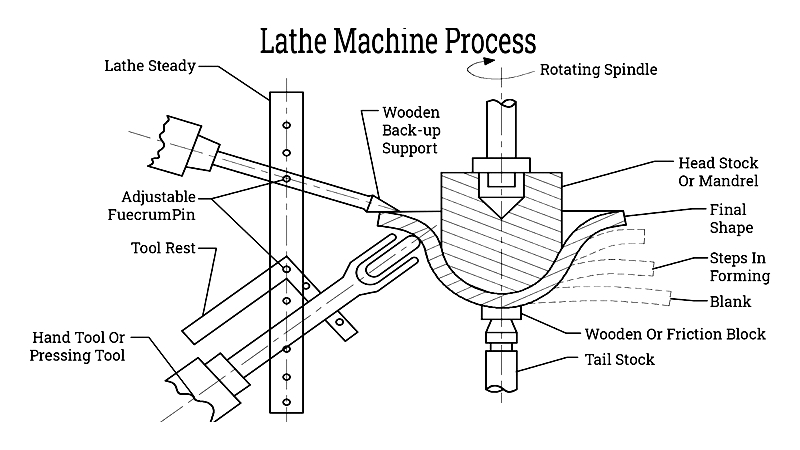Introduction
This section provides descriptions of metal spinning along with a list of highly qualified metal spinning companies.
You will learn about:
- The fundamentals of metal Spinning
- metal Spinning Machinery
- Different Types of metal Spinning
- metals used in metal Spinning
- Applications of metal Spinning
- And much more...

Chapter 1: What is metal Spinning?
metal spinning, also known as spin forming, is a metalworking process that transforms flat circular blanks or disc-shaped workpieces into axially symmetrical round shapes. This is achieved by applying lateral force through a roller positioned against the disc blank's surface and a mandrel shaped like the final part. The workpiece spins along the mandrel's axis at high speed, gradually taking the desired shape while the mandrel provides support and defines the final form.
metal spinning deforms circular metal sheets into various shapes without removing material. During the process, the disc blank experiences tensile and compressive forces as it wraps around the mandrel. Depending on the spinning method used, the original metal sheet's thickness may be reduced - a characteristic precisely controlled to meet specific requirements.

metal spinning combines art and science in an ancient metalworking technique dating back to Egyptian times. Over thousands of years, it has evolved from manual craftsmanship to a sophisticated manufacturing method incorporating computers and CNC technology.
The Middle Ages saw metal spinning gain significant importance for producing items like vases, tea kettles, and trophies. Craftsmen used manually powered wood spinning lathes with large flywheels operated by assistants.
Despite technological advancements, manual metal spinning remains valuable for producing high-tolerance, quality-finished products. Mastering the eye-hand coordination and skills required for manual operation demands extensive apprenticeship and unique abilities.
Chapter 2: metal Spinning Machinery
metal spinning machines, including spinning lathes and flow forming machines, shape metal blanks into round, hollow cylindrical parts, cones, and complex contours. A rotating lathe and hardened roller apply localized pressure to accurately form blanks made of aluminum, stainless steel, copper, brass, and titanium.
This advanced process delivers high repeatability and surface quality while maintaining flexibility for custom metal forming. The lathe serves as the primary machinery, rapidly spinning the workpiece while applying various tools. It also performs precision cutting, CNC drilling, and sanding. Custom mandrels form the workpiece's inner profile, working with other components to create intricate shapes with exceptional tolerances.

Mandrel
The mandrel acts as a forming die that gives volume and shape to the metal disc, matching the interior profile of the finished part. It supports the workpiece during high-speed rotation, ensuring even deformation without wrinkling or warping.
Before placement on the mandrel, workers lubricate the metal disc with grease or wax for easier removal after shaping. This lubrication also improves the final product's surface finish.
Manufacturers make mandrels from steel, aluminum, plastic, or wood, choosing less expensive materials for prototyping and short production runs. Regardless of material, the mandrel must withstand the force and stress applied by the rollers.
Roller
Rollers apply localized force to the workpiece over the mandrel, creating controlled plastic deformation. This force makes the workpiece flow over the mandrel into the desired shape. Roller ball bearings ensure smooth operation, limited heat generation, and minimal wear - crucial for working with hardened metals.
Adjusting rollers balances pressure and speed to produce uniform wall thicknesses and intricate contours. Operators can control rollers manually or through CNC systems, with CNC becoming increasingly popular. Manual operation requires significant skill, training, and experience to compete with modern technology.

metal spinning rollers apply much lower force than other metalworking processes. This allows forming high-strength, heavy-gauge metals into large diameters with significant energy savings.
The work zone forms a spiral path from the workpiece's rotation combined with the roller's forward motion. This produces seamless, high-strength spun parts with a twist that enhances structural integrity.
Tailstock
Positioned opposite the headstock, the tailstock holds the workpiece against the mandrel during rotation. Its precision adjustment mechanism maintains consistent clamping pressure, ensuring accuracy during high-speed or heavy-gauge spinning.
Follower
The follower is a pressure pad on the tailstock spindle that clamps the workpiece. Sized to match the spun part's base, it evenly distributes holding force to prevent slippage and ensures the blank conforms to the mandrel during rotation. Quality followers contribute to consistent surface finishes and repeatability.
Spindle
The headstock spindle is a shaft where the mandrel mounts, responsible for rotating both mandrel and workpiece during forming. A second spindle on the tailstock holds the follower. The main drive spindle serves as the axis for mandrel and workpiece, providing rotational energy. The tailstock spindle synchronizes with the follower for axial support and movement control. Manufacturers use direct-drive and belt-drive spindles to meet specific speed and torque requirements.
Headstock
The headstock frame contains mechanisms that transmit power to drive the spindles and control rotation speed. It houses the powertrain's motors and gears for speed control, high torque, and spindle alignment. The headstock stabilizes the assembly during high-speed rotation, ensuring safety and dimensional accuracy.
Lathe Bed
The lathe bed supports all machine components, serving as the engineering foundation with rigid, vibration-dampening properties. It maintains alignment of the headstock, tailstock, and tool rests under operational loads. A precisely machined, robust lathe bed ensures process consistency and equipment longevity.

Computer Numerical Control (CNC) metal Spinning
CNC metal spinning automates the process using computer-controlled lathes. Initial steps resemble manual spinning: the operator places the workpiece on the CNC lathe drive, securing it with a pressure pad.
CAD software designs the final part's form, with parameters converted to G-codes and M-codes for the CNC machine. These codes guide components during spinning. When activated, the CNC lathe rotates and presses the workpiece against the mold, deforming it to shape like manual lathes.
CNC spinning offers low-cost production with superior tensile strength, excellent finishes, and refined grain structures. It achieves dimensional stability within 0.001 inches or 0.01 millimeters. Industries use CNC spinning for low-to-high volume production of aerospace components, lighting reflectors, gas cylinders, and custom industrial products. Automation reduces operator error, cuts costs, and allows quick changeovers between product runs.
Playback Numerical Control (PNC) metal Spinning
PNC spinning uses a joystick for manual shaping. once achieved, the program saves the operator's movements for repetition. Adjustments improve accuracy by removing inefficient program aspects.
Effective for high-volume production, PNC lathes in playback mode repeatedly duplicate the original part. Operators simply place blanks on the lathe and initiate the playback cycle.
Chapter 3: Types of metal Spinning
Spinning is classified as compressive draw forming due to radial, tensile, and compressive stresses affecting metal flow in the roller work zone and adjacent areas. Tensile stresses occur when the roller contacts the workpiece, increasing with axial roller feed to create volumetric displacement radial to the mandrel.
As metal volume decreases toward the center, compressive




